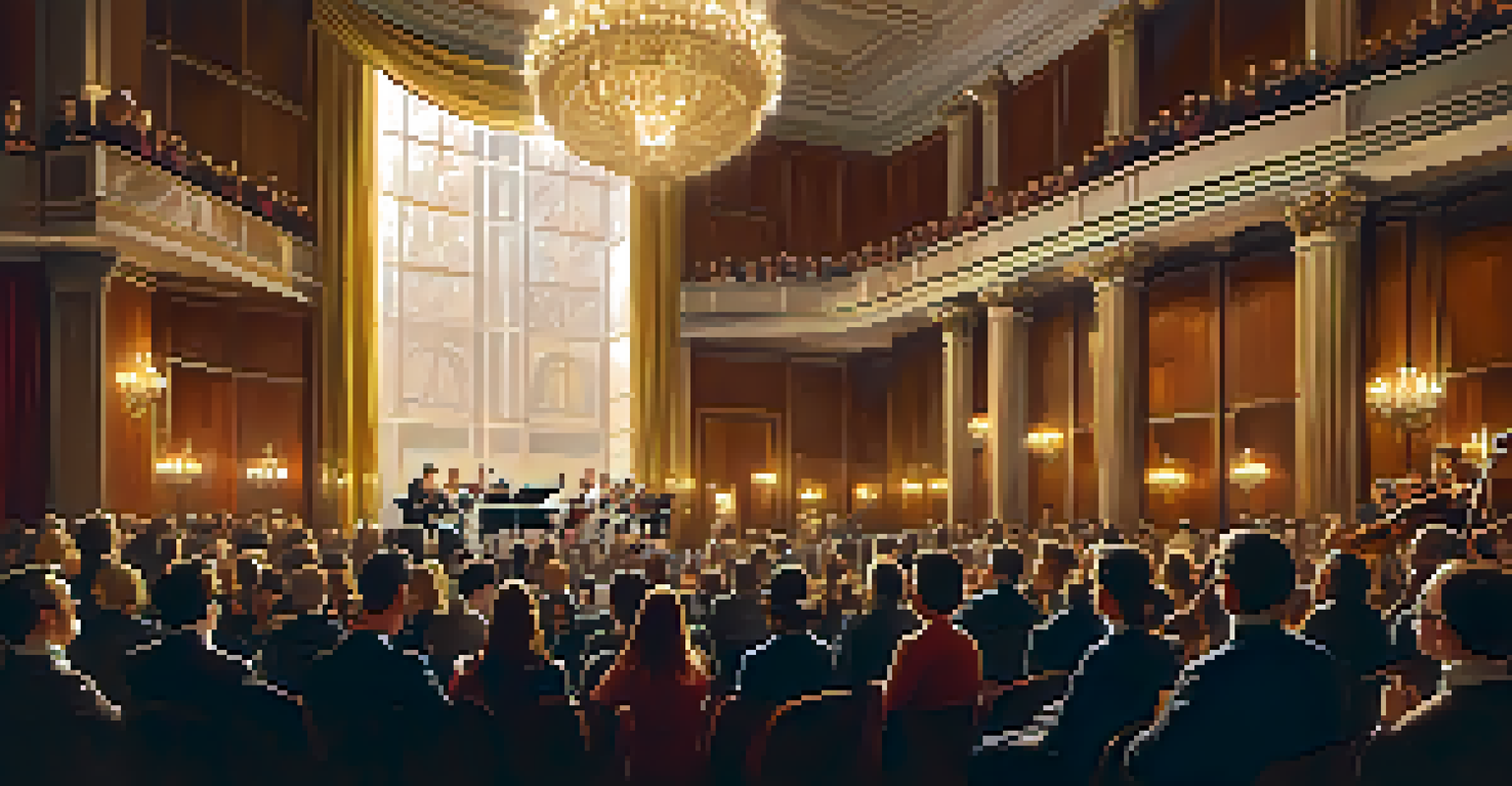The Role of Music in Film: Enhancing Storytelling Through Sound

Understanding the Impact of Music on Emotions in Film
Music has a profound ability to evoke emotions, setting the tone for a film. Think about the last time you felt a chill during a suspenseful scene; that effect often comes from the score. From heartwarming melodies to haunting notes, music guides the audience's feelings and reactions.
Music can change the world because it can change people.
When we hear a triumphant theme, it can make us feel proud or empowered. Conversely, a minor key can create a sense of sadness or dread. This emotional manipulation is a powerful tool for filmmakers, helping to create a deeper connection between the audience and the story.
Ultimately, music is not just an accompaniment; it's a critical element that shapes our experience of the narrative. As viewers, we may not always recognize its influence, but it’s there, subtly steering our emotions throughout the film.
Creating Atmosphere: Setting the Scene with Sound
Music helps to create an atmosphere that transports the audience into the film’s world. Imagine the sweeping orchestral score in a grand fantasy epic versus the minimalist sounds in a tense thriller. Each score serves a different purpose and enhances the atmosphere in unique ways.

For instance, in horror films, unsettling sounds and dissonant chords can build tension and anticipation. A well-composed score can make even mundane settings feel extraordinary or ominous, guiding viewers' perceptions of the environment.
Music Shapes Emotions in Film
The score of a film profoundly influences the audience's emotional experience, guiding their feelings throughout the narrative.
By establishing the scene through music, filmmakers can immerse the audience in the story, making them feel as if they are part of the action. This atmospheric quality is what often lingers in our minds long after the credits roll.
Character Themes: Musical Identity and Development
One fascinating aspect of film music is the use of character themes, which are musical motifs associated with specific characters. Think of Darth Vader’s menacing theme in 'Star Wars'; it instantly evokes a sense of his power and presence. These themes help to define characters and their journeys.
The music is the soundtrack of your life.
As the story progresses, a character's theme may evolve, reflecting their growth or challenges. For example, a hero's theme might become more complex as they face adversity, symbolizing their internal struggles. This musical evolution adds depth to character development.
By linking music to character identities, filmmakers create a richer narrative experience. Audiences can feel a stronger connection to characters when their emotions are mirrored by their accompanying scores.
Foreshadowing and Musical Cues: Hinting at What’s to Come
Music can serve as a tool for foreshadowing, subtly hinting at future events in the story. Composers often use recurring motifs to build anticipation and suspense. For example, a particular chord progression may signal an impending danger, alerting the audience before the characters are aware.
These musical cues can create a sense of foreboding, allowing viewers to engage more deeply with the plot. When the score hints at what's to come, it invites the audience to piece together clues and engage in the storytelling process.
Character Themes Enhance Narratives
Musical motifs linked to characters add depth to their identities and journeys, creating a stronger bond with the audience.
Ultimately, using music for foreshadowing enhances the narrative’s complexity, turning passive viewers into active participants. It’s a clever way to intertwine sound with storytelling.
Cultural Context: Music as a Reflection of Time and Place
Music in film often reflects the cultural context of the story, enhancing authenticity and relatability. Whether it's a jazz score in a 1920s setting or traditional folk music in a rural tale, the right soundtrack can transport viewers to a different time and place. This cultural connection adds depth and richness to the narrative.
For instance, films set in specific regions often incorporate local music styles, which can resonate with audiences familiar with those sounds. This not only enriches the viewing experience but also elevates the film's credibility.
By integrating music that aligns with the film’s cultural backdrop, filmmakers create a more immersive experience, making the story more believable and engaging for the audience.
The Role of Silence: Enhancing Impact Through Absence
While music plays a crucial role in film, silence can also be incredibly powerful. Strategic moments of silence can create tension, allowing viewers to process emotions or anticipate what happens next. This absence of sound often amplifies the impact of subsequent musical cues.
For example, in a climactic scene, a sudden drop to silence can heighten suspense, making the audience hold their breath. When music returns, it can feel even more powerful, creating a dramatic contrast that enhances the overall experience.
Silence Amplifies Dramatic Impact
Strategic use of silence in film can heighten tension and enhance the emotional weight of subsequent musical cues.
By skillfully balancing music and silence, filmmakers can manipulate pacing and emotional intensity, giving the audience a more dynamic viewing experience. It’s a delicate dance that reflects the complexity of storytelling.
Collaborative Art: The Relationship Between Composers and Filmmakers
The relationship between filmmakers and composers is a collaborative art form, blending visuals and sound into a cohesive narrative. Directors often work closely with composers to ensure the score aligns perfectly with the emotional beats of the film. This synergy is essential for creating a seamless experience for the audience.
For instance, iconic collaborations, like that of director Christopher Nolan and composer Hans Zimmer, showcase how well-crafted scores can elevate a film's impact. Their partnership highlights the importance of musical storytelling in enhancing cinematic experiences.

Ultimately, this collaboration allows filmmakers to explore new creative avenues, resulting in memorable films. The music becomes an integral part of the storytelling process, showcasing the power of teamwork in the creative arts.